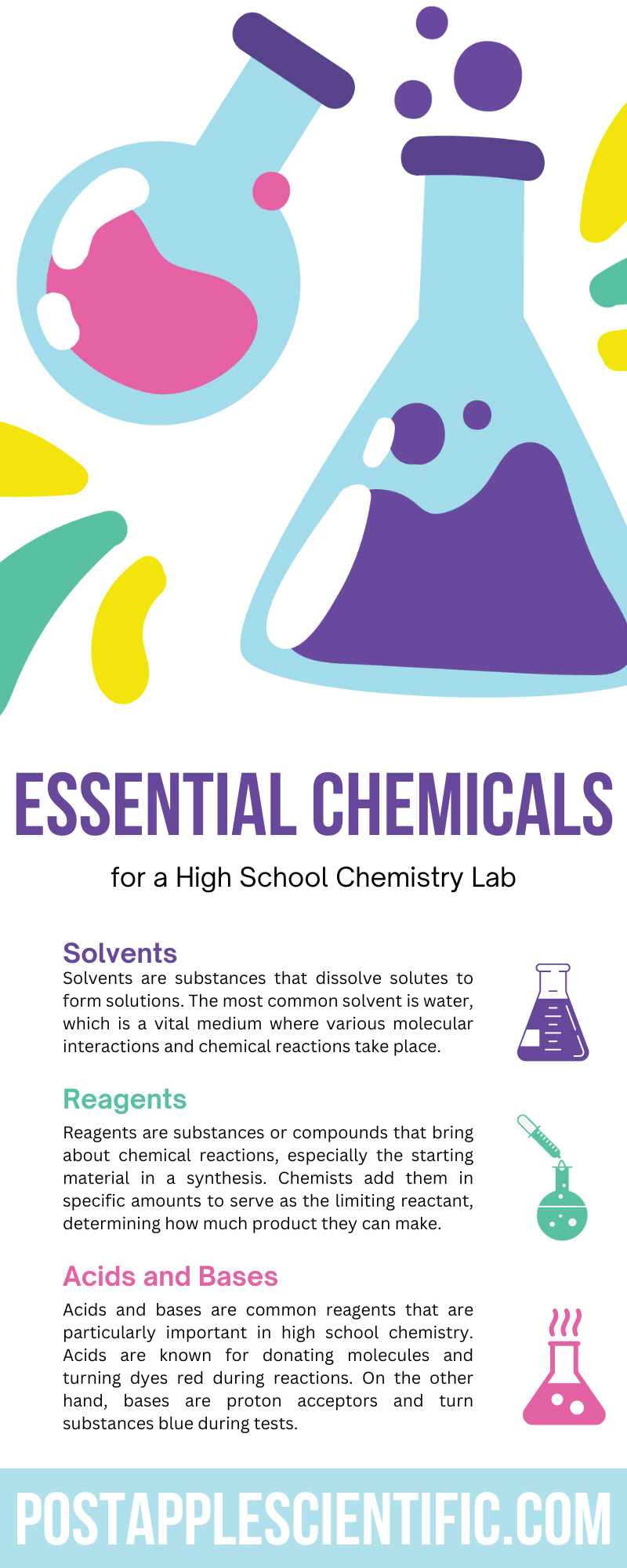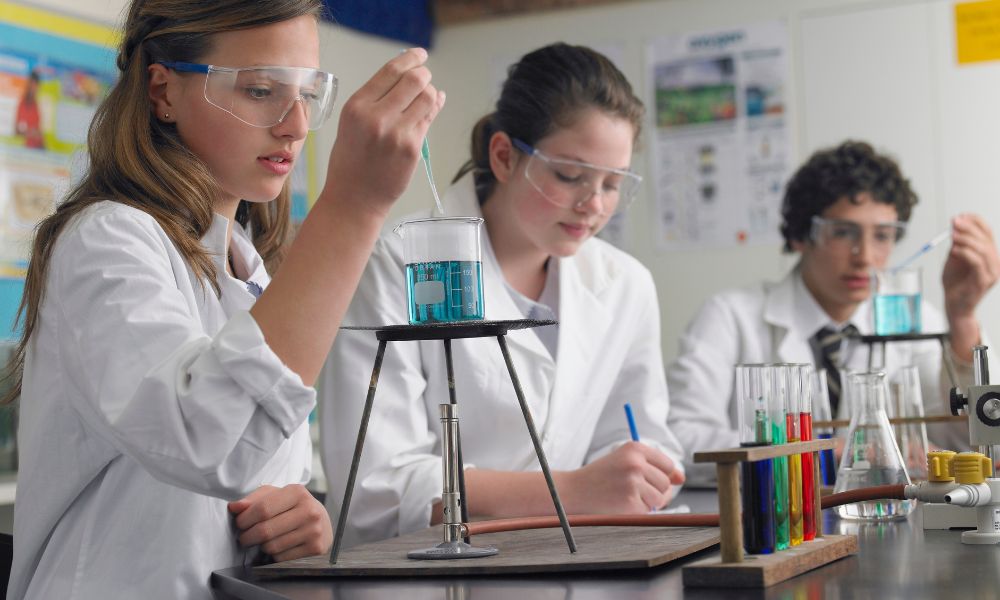High school chemistry labs are places of scientific discovery and hands-on learning. These environments are where students get to witness the magic of chemical reactions and understand the importance of chemistry in daily applications. Understanding which chemicals are essential to the lab can improve the educational experience for chemistry students. Understanding which chemicals your lab uses most often is key to keeping your laboratory storage stocked. Here is an educational list of the six essential chemicals for a high school chemistry lab.
Understanding the Importance of Chemicals in Science Education
Understanding why we use these chemicals in the first place is important before exploring the common lab chemicals. High school labs are not just about conducting experiments; they’re environments where students learn to approach problems scientifically, develop critical thinking skills, and appreciate the natural principles governing our world.
Chemistry labs teach students the basics of working with chemicals and conducting experiments—these environments are where prospective chemists learn the basics. Each chemical plays a distinct role, contributing to safety lessons, breaking down chemicals, and learning more about reactions. This lab experience is a key stepping stone to a career in chemistry for some students.
Types of Chemicals Every Lab Needs
Below are six essential chemical categories your high school chemistry lab can’t thrive without, including a deeper look at their roles and some examples of each.
Solvents
Solvents are substances that dissolve solutes to form solutions. The most common solvent is water, which is a vital medium where various molecular interactions and chemical reactions take place. Other solvents include acetone, methanol, and ethanol which have their own solvent properties and are also key players in interactions.
Reagents
Reagents are substances or compounds that bring about chemical reactions, especially the starting material in a synthesis. Chemists add them in specific amounts to serve as the limiting reactant, determining how much product they can make. Some examples of reagents include sulfuric acid, sodium hydroxide, and silver nitrate—each is essential for different types of reactions.
Acids and Bases
Acids and bases are common reagents that are particularly important in high school chemistry. Acids are known for donating molecules and turning dyes red during reactions. On the other hand, bases are proton acceptors and turn substances blue during tests. Acids like hydrochloric acid and bases like sodium hydroxide are keystones for classroom titrations and analyses.
Organic Versus Inorganic Compounds
Organic chemicals contain carbon, which can form covalent bonds with other elements. Conversely, inorganic compounds do not contain carbon. Each class of compounds has its significance and includes many elements that students can identify in and out of the laboratory.
Disinfectants and Safety Solutions
Ensuring safety is of utmost importance in any laboratory environment. It is crucial to use disinfectants and safety solutions to uphold a hazard-free workspace. 70% ethanol can effectively sanitize surfaces when conducting a surface cleaning. Additionally, for thorough decontamination procedures, hydrogen peroxide and bleach are common chemicals for maintaining a safe and sterile laboratory setting.
Chemical Dyes
Chemical dyes color solutions, imparting visual educational benefits in high school settings. Substances like phenolphthalein, methyl orange, and blue and red litmus are standard tools in the chemist’s palette, signaling the presence of specific pH levels and helping students visualize the intangible transformations.
Most Common Chemistry Lab Chemicals
Now that you know the general categories of common lab chemicals, here are some specifics that you will often find on their storage shelves. Certain chemicals are indispensable, from the tip of your pipette to the depths of your storage cabinet.
Nitric Acid
Nitric acid is instrumental in everything from agriculture to explosives, giving it a real-world relevance that students can appreciate. Chemists can use nitric acid for everything from chloride testing to cleaning in the chemistry lab.
Sodium Hydroxide
Manufacturers feature sodium hydroxide when creating soaps, rayon, and paper, highlighting the connections between products and their chemical origins that are often lost in consumption. Sodium hydroxide is a strong base that creates strong reactions with acids.
Sulfuric Acid
An old favorite in the laboratory, sulfuric acid is omnipresent due to its use in the industrial production of many substances, including nitric acid and phosphoric acid, two other laboratory stalwarts.
Ethanol
Ethanol stands out for its versatility and essential role in both educational and research settings. Its applications range from serving as a key ingredient in the preparation of various organic compounds to its use as a cleaning agent for wiping down laboratory equipment.
Why Chemicals Are Essential to the Lab
The six categories outlined above represent the core constituents of any chemical setting, ensuring the lab is functional and reflective of real-world scientific exploration.
Chemicals aid in teaching about the properties of matter, conducting experiments to deduce natural laws, and laying the foundation for future studies and careers. The solubility of salts, the pH scale, and redox reactions are but a few examples of topics best learned through practical experimentation with the right elements at the students’ disposal.
Chemistry Lab Chemical Accessories and Equipment
Alongside the chemicals themselves, a high school lab is incomplete without the proper accessories and equipment. Fume hoods, calibrated glassware, such as volumetric flasks and pipettes, safety goggles, and fire extinguishers are part of any lab’s security and functionality. It’s crucial to maintain these items in good working order and replenish them as needed for a safe and efficient lab experience.
Along with having the right chemicals, having proper safety equipment and laboratory tools helps students learn more about the chemistry field. Every chemist knows the importance of donning PPE in the lab and handling glassware carefully. The high school lab setting is the perfect place to introduce and practice these skills as a budding chemist.
You can find all the key materials you need at Post Apple Scientific, whether you want to stock your lab with chemicals or lab equipment. We provide lab chemical supplies for applications ranging from high school lab settings to industrial facilities. Trust the quality of our chemicals to teach your students these critical chemistry basics and skills.
These chemicals lead the way to innovation, discoveries, and the relentless pursuit of knowledge, from high school to professional laboratories. Exploring these chemicals and their role in the high school lab has shown that these are key building blocks in a student’s scientific education.
A high school chemistry lab is a starting ground, a place where curiosity meets reality. You’re not just creating a room to carry out experiments; you’re fostering an environment for growth and scientific inquiry when you equip your high school chemistry lab with essential chemicals and prepare your students with the proper knowledge. We pave the way for future scientists in this exciting field by recognizing each chemical’s significance.


